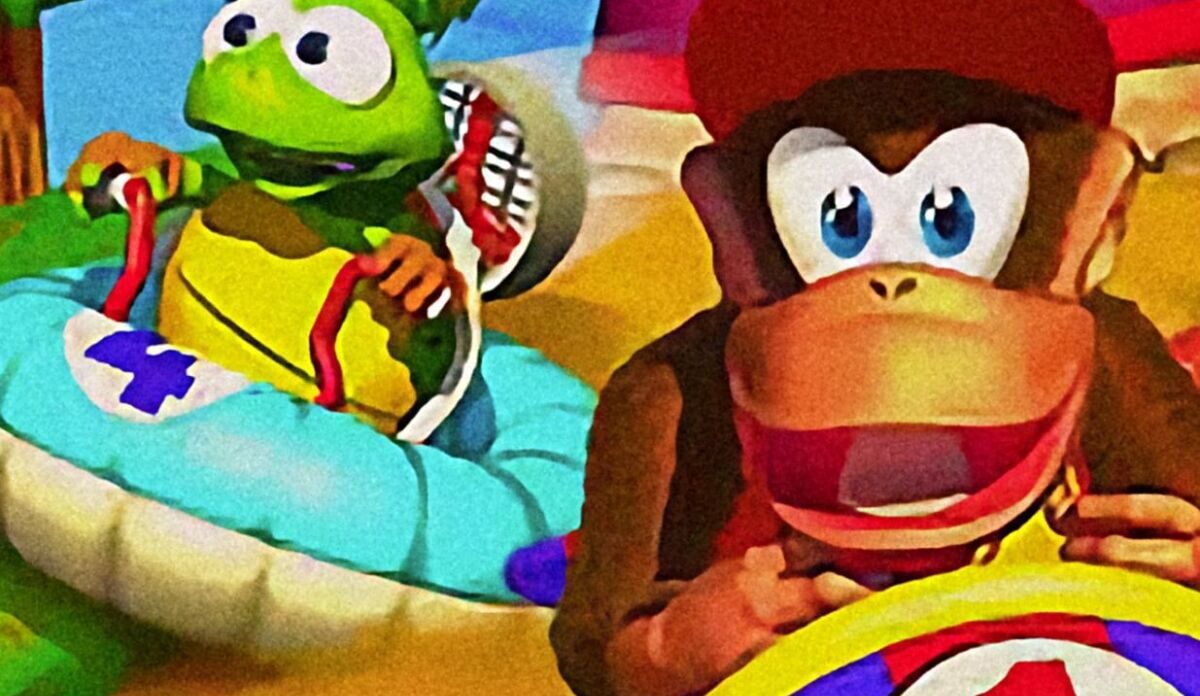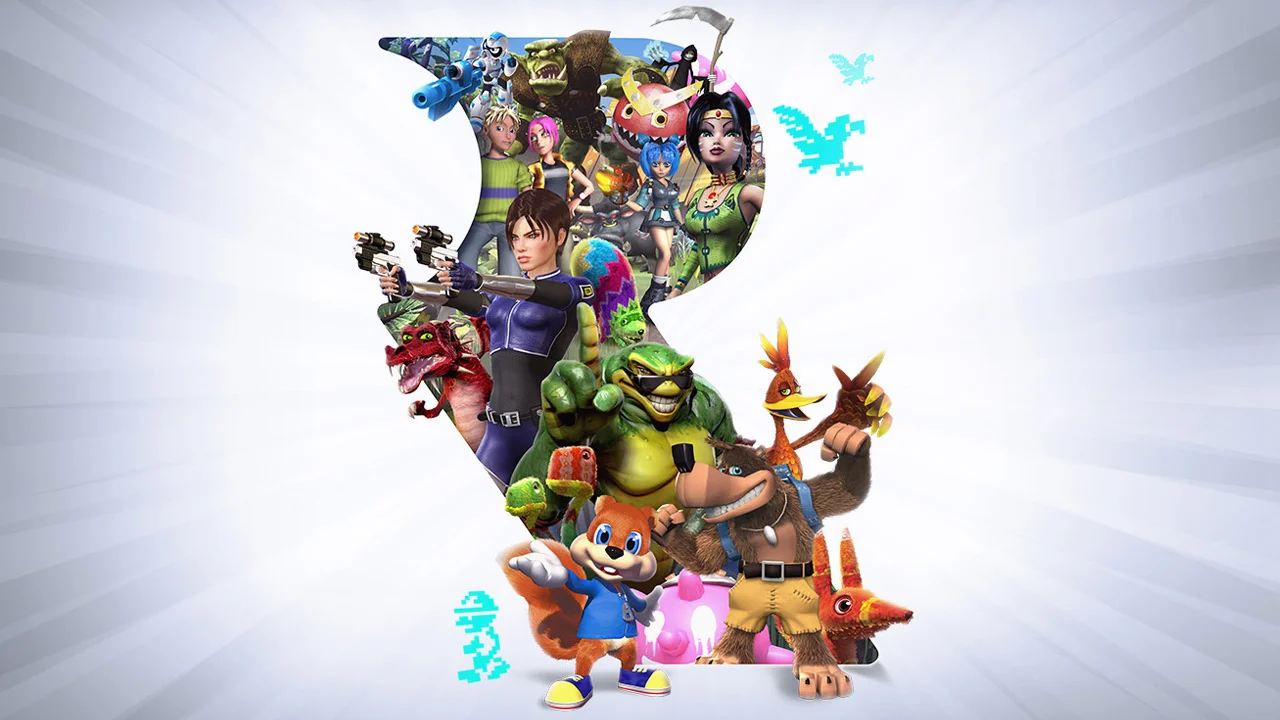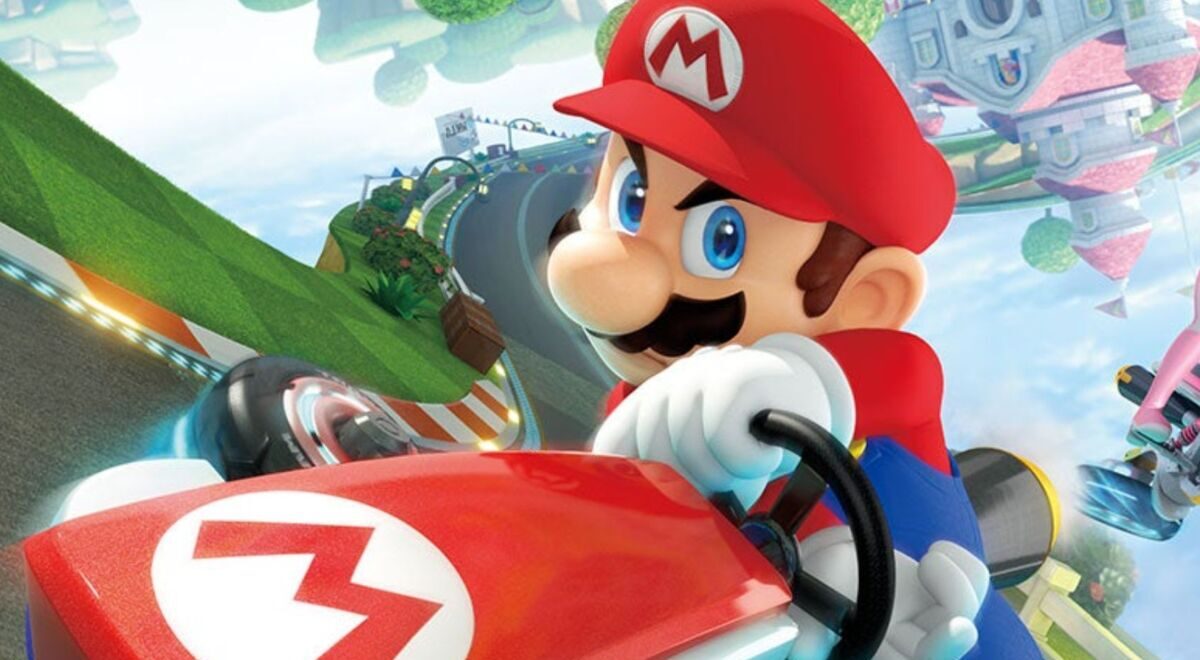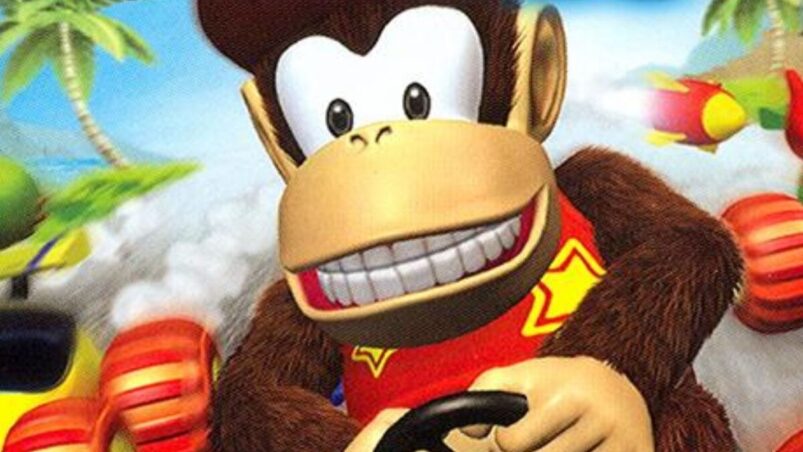They ride mine carts, travel by barrels, and swing on vines, but did you know the Donkey Kong characters also like to kart race?
The franchise has two racing titles and two more were planned. The first game, Diddy Kong Racing, is even considered by many as superior to Mario Kart 64, with IGN’s 1997 review saying, “subtle details, blissful gameplay and graphics, and the full, rich world [make] Diddy Kong Racing an even better game than Mario Kart.”
With Mario Kart having eight entries (nine if you count the mobile game Mario Kart Tour), it’s clear which kart racer series Nintendo prioritizes the most. Given Nintendo’s love for bringing back old properties for the Switch, though, it’s surprising how the Donkey Kong racing games never made a return, especially considering how dormant Donkey Kong in general has been as of late. The last new release was Tropical Freeze for the Wii U back in 2014, and while that was re-released for the Switch in 2018 and the Switch remake for Mario vs. Donkey Kong is set to release this February, we’re long overdue for an actual new title from the franchise.
Since it’s been nearly a decade since we’ve received a new platformer, should Nintendo shift gears and release a new Donkey Kong racing game instead?
If so, does such a game even have a place in the current gaming landscape, with everything from Nickelodeon to Sonic to Disney having their own kart racers? While the genre may currently be an oversaturated one, it’s interesting to look back on how the Donkey Kong franchise even got a racer to begin with, and what stopped Nintendo from ever releasing more entries.
Diddy Kong Racing – The Greatest Reskinned Game Ever

The Nintendo 64 was released in 1996, two years after the PlayStation’s release in 1994. Because it had so few games — only 388 when PlayStation had over 7,000 — the console’s library had to focus on quality over quantity, especially early on in its release.
“Who has the hot games? We’ll call this one a draw for now,” Forbes wrote in 1997 about Nintendo and Sony. “Who has the most games? Sony by a mile. There are over 300 PlayStation titles versus 30 for Nintendo.”
That’s why Diddy Kong Racing was such an important release in 1997. It was originally meant to feature a brand new IP and was called Wild Cartoon Kingdom, which then became Pro-Am 64 as game developer Rare wanted to revitalize a previous racing game series they had called R.C. Pro-Am, which had been dormant for six years.
However, when Banjo-Kazooie was delayed and Nintendo needed another big holiday release in 1997, Diddy Kong from Donkey Kong Country was added to Pro-Am 64 as a playable character. The game was then retitled Diddy Kong Racing, to add brand name recognition to the product and ensure it sold better.
Calling Diddy Kong Racing a Donkey Kong game almost feels like a stretch, as Diddy Kong is the only character present from the franchise. That said, two of the eight playable animal characters actually come from future N64 games: Banjo from 1998’s Banjo-Kazooie and Conker from 2001’s Conker’s Bad Fur Day.
Conker’s appearance is especially humorous given how different the character becomes when he gets his own N64 game. Conker in Diddy Kong Racing is cute, bubbly, and says “I’m Conker!” in a happy-go-lucky way when you choose him from the Player Select menu. Conker in Conker’s Bad Fur Day is a foul-mouthed smoker whose game begins with him trying to get to his girlfriend’s home after a night of binge drinking.
Another thing these Diddy Kong Racing, Banjo-Kazooie, and Conker’s Bad Fur Day all share in common is that they were developed by Rare, Nintendo’s second-party developer from 1994 to 2002. Nintendo had a 49% stake in the company, so if you owned any Nintendo console from this era, chances are high that you’ve played a Rare game. The studio developed several successful games for these consoles such as the Donkey Kong Country games, Battletoads, GoldenEye 007, and Perfect Dark.
(Contrary to popular belief, Rare was never called Rareware. That was a portmanteau of Rare and Software, and was in reference to the studio’s games, but not the studio itself. The company was always Rare Limited.)
True to form, Diddy Kong Racing was another big hit from the studio. The game sold over a million units in 21 days and 4.8 million copies in total, making it the N64’s 8th best-selling game of all time. The critical reception was fantastic too, with GamePro calling it “feverishly fun” and “one spectacular game”, and the Academy of Interactive Arts & Sciences awarding it “Console Racing Game of the Year” in 1998, beating fellow racers Mario Kart 64, Moto Racer, and NASCAR 98.
Unsurprisingly, Diddy Kong Racing’s biggest triumphs were all the things that made it distinct from the Mario Kart games, and really, most games in the genre. Diddy Kong Racing didn’t have item boxes that gave you a random power-up. Instead, its item boxes were balloons of different colors, and each color contained a specific power-up. Not only that, but if you hit one balloon and then another of the same color after, your power-up would upgrade, and there were multiple fun upgrades you could try out and experiment with.
The game allowed you to race in three different vehicles: a kart, a hovercraft, and an airplane. Many of the levels were cleverly designed to provide a different experience with each vehicle, and also include shortcuts that can only be accessed by specific ones. The hub world was also unique as it felt more like a platformer’s hub world. You could explore it, find hidden items, and driving to a level rather than just clicking it from a list was plenty of fun, especially for a kid.
By all means, it seemed like Nintendo had struck gold with two lucrative kart racing franchises to their name: Mario Kart and Diddy Kong Racing. Mario Kart received tons of sequels, so why didn’t Diddy Kong Racing get even just one?
A Bananas Amount of Canceled Games
At E3 2001, Nintendo announced two sequels to the original DKR: Donkey Kong Racing for the GameCube, and Diddy Kong Pilot for the Game Boy Advance. A pre-rendered video of Donkey Kong Racing was shown during this event, which featured characters like Donkey, Diddy, and Kiddy Kong riding on animals like rhinos, fishes, and giant bees, and the giant bee scene was a parody of the speeder bike chase from Return of the Jedi.
According to a 2014 interview with the game’s lead designer Lee Musgrave, Donkey Kong Racing would’ve had its players ride on animals and be able to switch between different types of animals mid-race, as different animals offered different advantages for racing. “The idea […] was that the player wouldn’t be constricted to just a single animal when racing,” Musgrave said.
Of course, neither Donkey Kong Racing nor Diddy Kong Pilot were ever completed because of one big event that happened in 2002: Rare was bought out by Microsoft for $375 million. As game development costs were growing more and more expensive, Rare’s partnership with Nintendo wasn’t efficient enough for them anymore, and Nintendo decided to cut ties and officially end their relationship with Rare.
It was a surprise to everyone that Nintendo decided not to acquire the company. “I’ve no idea why they didn’t do that,” co-founder Tim Stamper said in 2015. “I thought we were a good fit.”
Microsoft was determined to purchase Rare, even outbidding Activision at the last minute for the company. Because of this acquisition, many Nintendo games ceased production or were reworked into different games instead.

Donkey Kong Racing eventually became Sabreman Stampede, an open-world Tamagotchi-style game that was part of Rare’s Sabreman series. It was set for release on the Xbox 360, but was cancelled due to Rare being unfamiliar with the console and the scope of the game becoming too wide.
“The development went off into the woods a little bit,” Musgrave said. “It took a long time to do, and at the same time we were trying to build engines for consoles we weren’t familiar with.”
Diddy Kong Pilot, however, was converted into Banjo-Pilot, a Banjo-Kazooie kart racer game released for the Game Boy Advance. Gameplay of the original Diddy Kong Pilot did surface in 2011 thanks to a YouTube user named Transparentjinjo.
Finally, there was one more potential Donkey Kong racing game: Diddy Kong Racing Adventure. This was a rejected pitch made by Climax Studios for the GameCube around 2004. It was never publicly announced, but in 2016, a video game archivist named Andrew Borman acquired the prototype and published a video about it in his video series, Past to Present Online.
The mere fact that a studio was pitching a Diddy Kong Racing sequel is evidence of just how much people loved the original racing game, and how it could’ve led to a gigantic franchise had Nintendo continued their partnership with Rare. At this point, the GameCube was now Nintendo’s home console, and the only Donkey Kong games that were released for it were the spin-off rhythm games Donkey Konga and a spin-off score-attack game called Donkey Kong Jungle Beat.
However, after the Wii’s release in 2006, the very first Donkey Kong game available on the console was, rather unbelievably, a brand-new racing game. Too bad it was a terrible one.
Donkey Kong Barrel Blast (It Into Space)

The Wii received two new Donkey Kong games: Donkey Kong Barrel Blast and Donkey Kong Country Returns. One of them was a platforming masterpiece, filled with crazy-fun level designs and nostalgic music, and is considered one of the best platformers ever released.
The other is one of the worst Donkey Kong games ever made, and was unfortunately released first. Donkey Kong Barrel Blast was a racing game developed by Paon and released in 2007. This was the same year the Diddy Kong Racing enhanced remake was released for the Nintendo DS, making it even more insulting that this was the Wii’s first original title from the franchise. The remake was still developed by Rare, as Microsoft had no competing handheld console, but no longer featured Conker and Banjo as characters.
Barrel Blast was originally meant for the GameCube. The console’s spin-off rhythm game Donkey Konga, developed by Namco, had you bang to the beat of the music on a special controller called the DK Bongos, which were essentially toy bongo drums you connected to the console. For some reason, Nintendo was adamant about this accessory being used for more than one game, so the GameCube received two Donkey Konga sequels and a score-attack game called Donkey Kong Jungle Beat, which were all compatible with the DK Bongos.
Donkey Kong Barrel Blast was meant to be the fifth compatible game with the accessory and even had the working title DK Bongo Blast. When it got delayed and reworked for the Wii, the game used the Wiimote and Nunchuk motion controls instead, mimicking the motion of banging on two bongo drums. It’s strange considering the Wii did have GameCube ports, which several Wii accessories used, so the decision to get rid of DK Bongos controls entirely felt unnecessary.
It doesn’t help, either, that the motion controls for Barrel Blast are abysmal. This is a strange racing game as the characters aren’t driving traditional vehicles. They’re instead driving jet-powered bongos, so to drive them, you have to bang the left or right bongo by shaking the Wiimote or Nunchuk depending on which direction you want to steer.
At least with the DK Bongos, you felt like you were banging on something concrete, but with the Wiimote and Nunchuk, it just felt like you were shaking your fists in the air. Oddly enough, the Wiimote and Nunchuk controls for 2010’s Country Returns were excellent, so Barrel Blast’s terrible controls only pale more in retrospect.
It wasn’t just the controls, though — the game had outdated graphics, unexciting racing, and even lacked an online mode and leaderboards. Barrel Blast received an incredibly low 46 on Metacritic, with Official Nintendo Magazine UK calling its steering mechanic “an insult to your gaming ability” and Game Informer writing, “The lack of online racing and leaderboards makes this game even more useless.”
Mario Kart Wii was released a year later and was a huge critical and commercial success, eventually being considered as the best party racing game for the console. There was very little reason for anyone to revisit Donkey Kong Barrel Blast, and Nintendo hasn’t released another Donkey Kong racing game in over 16 years.
Should the Kongs Race Again?

In the 2017 game Hey! Pikmin for the 3DS, one of the items you can collect is a Game Boy cartridge of Donkey Kong Land, a game developed by Rare. This collectible was given the title “Enduring Partnership”, which greatly suggests that while Nintendo parted ways with Rare over 21 years ago, the company is still grateful for the developer studio and looks back on their partnership fondly.
This opens up multiple possibilities: Could Banjo ever fight in a Smash game? Could Fox McCloud ever race in a Mario Kart entry? Most importantly, could Diddy Kong Racing ever get the sequel it deserves?
Probably the biggest thing stopping Nintendo from a Donkey Kong racing game is the utter popularity of the Mario Kart franchise. Mario Kart 8 Deluxe remains the best-selling Nintendo Switch game of all time, selling over 60 million copies despite being a rerelease of a game originally released in 2014. If Nintendo wants to focus on any racing game franchise, it’s that one, especially since multiple Donkey Kong characters are already playable there.
However, Diddy Kong Racing had features that Mario Kart and many other kart racers still haven’t incorporated into their games, like choosing from three incredibly different vehicles, having color-coded item boxes, and driving around an explorable hub world.
1999’s Crash Team Racing does have a hub world and so does its remake, which makes sense considering during the prototype stage of the original game, Naughty Dog built a replica of “Crescent Island” from Diddy Kong Racing to see whether a racetrack of that size and scope was possible on the PlayStation. It isn’t far-fetched to consider that Crash Team Racing was significantly influenced by Diddy Kong Racing, and a sequel to the latter title still has its place in the crowded kart racer genre.
That is, as long as Nintendo remembers fans don’t want a Mario Kart clone. We want a new Diddy Kong Racing game for all the things that made the original so unique. Even if it doesn’t turn out well, though, chances are high that we’ll be able to say, “At least it wasn’t Donkey Kong Barrel Blast.”
READ NEXT: Ranking Every Grand Theft Auto Game From Worst To Best
Some of the coverage you find on Cultured Vultures contains affiliate links, which provide us with small commissions based on purchases made from visiting our site.

